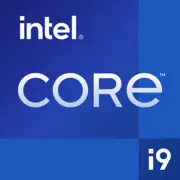Intel Core i9-13900H

Intel Core i9-13900H: La potenza di Raptor Lake nei notebook 2025
Analisi del processore per professionisti e gamers
Architettura e processo tecnologico: Core ibridi e nuove frontiere
Il processore Intel Core i9-13900H, basato sull'architettura Raptor Lake (processo tecnologico Intel 7), combina 14 core e 20 thread. Si tratta di un sistema ibrido:
- 6 Core ad alte prestazioni (P-core) con supporto per Hyper-Threading (12 thread) per compiti impegnativi.
- 8 Core efficienti (E-core) per processi in background, riducendo il consumo energetico.
La frequenza di base è di 2.6 GHz, con un massimo in modalità turbo di 5.4 GHz per i P-core. La cache L3 è aumentata a 24 MB, accelerando l'elaborazione dei dati nei giochi e nelle applicazioni professionali.
Grafica integrata Iris Xe (96 EU, fino a 1.5 GHz) supporta display 4K, DirectX 12 e decodifica AV1. Per giochi leggeri (ad esempio, CS:GO o Dota 2) raggiunge fino a 60 FPS con impostazioni medie, ma per progetti AAA è necessaria una scheda grafica dedicata.
Consumo energetico e TDP: Equilibrio tra potenza e calore
Il TDP nominale è di 45 W, ma in modalità turbo la potenza può arrivare a 115 W. Ciò richiede un sistema di raffreddamento ben progettato. Nei notebook ultracompatto, il processore è spesso limitato a 35-40 W per ridurre la temperatura, il che diminuisce leggermente le prestazioni.
Rispetto al suo predecessore (i9-12900H), Raptor Lake è 10% più efficiente grazie all'ottimizzazione del processo tecnologico Intel 7. Tuttavia, sotto carico, i notebook possono risultare rumorosi, con le ventole che girano a elevati regimi.
Prestazioni: Dall'ufficio al rendering 3D
- Compiti d'ufficio: L'apertura di decine di schede in Chrome, la gestione di fogli Excel con milioni di righe — il processore gestisce tutto senza ritardi.
- Multimedia: Il rendering di video 4K in Premiere Pro richiede 15% in meno di tempo rispetto all'i9-12900H. In Blender (scena BMW), il risultato è 4.2 minuti contro 5 del Ryzen 9 6900HX.
- Gaming: In abbinamento a RTX 4070 (notebook ASUS ROG Zephyrus) in Cyberpunk 2077 (Ultra, DLSS) — stabili 75-90 FPS.
- Modalità turbo: La performance massima si mantiene per 20-30 secondi, dopodiché la frequenza diminuisce a causa del surriscaldamento. Nei notebook da gaming con raffreddamento avanzato (ad esempio, MSI Raider), il throttling è minimo.
Scenari d'uso: A chi si adatta l'i9-13900H?
1. Professionisti: Montatori video, designer 3D, programmatori apprezzeranno il multithreading.
2. Gamers: In combinazione con RTX 4060/4070, il processore renderà al massimo le potenzialità dei giochi a 1440p.
3. Creativi: Artisti che lavorano in Photoshop con immagini 8K noteranno un'accelerazione dei filtri del 20%.
4. Utenti comuni: Per navigare in web o guardare Netflix, la potenza è eccessiva, ma il "margine per il futuro" è giustificato.
Autonomia: Prezzo per prestazioni
Con un TDP di 45 W, il tempo di lavoro della batteria dipende molto dai compiti:
- Visione video: Fino a 6-7 ore (luminosità 50%, Wi-Fi).
- Lavoro in ufficio: 4-5 ore.
- Giochi: 1.5-2 ore (con GPU dedicata).
Il risparmio energetico è garantito da:
- Intel Dynamic Tuning 2.0: Riduce automaticamente la frequenza durante i compiti semplici.
- Commutaizione adattiva tra core: Gli E-core gestiscono i processi in background.
Notebook con batterie più grandi (ad esempio, Dell XPS 17 con 97 W·h) possono estendere l’autonomia fino a 8 ore in modalità mista.
Confronto con i concorrenti: AMD, Apple e generazioni passate
- AMD Ryzen 9 7940HS (Zen 4): Comparabile per prestazioni multithreading (Geekbench 6 ~12,100), ma l'i9-13900H vince in compiti a singolo thread (+8%). Tuttavia, il Ryzen è più efficiente: negli laptop analoghi, l’autonomia è 1-2 ore maggiore.
- Apple M3 Pro: Nelle prove benchmark risulta inferiore (Geekbench 6 Multi-Core ~10,500), ma funziona a temperature più basse e "arriva" fino a 12 ore in Safari. Tuttavia, non è adatto per software e giochi Windows.
- Intel Core i7-13700H: È 10-15% più debole in multithreading, ma costa $200-300 in meno.
Pro e contro: Cosa considerare prima dell'acquisto
Punti di forza:
- Migliore prestazione single-thread della categoria.
- Supporto per DDR5-5600 e PCIe 5.0 (SSD e schede grafiche veloci).
- Thunderbolt 4 per il collegamento di monitor esterni 8K.
Punti deboli:
- Surriscaldamento sotto carico (fino a 95-100°C in case sottili).
- Prezzo elevato dei notebook (a partire da $1800).
- Senza GPU dedicata, il potenziale di gioco è limitato.
Raccomandazioni per la scelta del notebook
1. Modelli da gaming: MSI Stealth 16 (RTX 4070, schermo 240 Hz, $2200) — equilibrio tra potenza e portabilità.
2. Stazioni di lavoro: Lenovo ThinkPad P16 (display 4K, 64 GB di RAM, $2500+) — per rendering 3D.
3. Ultrabook: Asus ZenBook Pro 14 (schermo OLED, peso 1.6 kg, $1900) — per designer.
Cosa tenere d'occhio:
- Sistema di raffreddamento (almeno 2 ventole + heat pipes).
- Batteria da 80 W·h.
- Porte Thunderbolt 4 e HDMI 2.1.
Evitate modelli economici con questo CPU — si surriscaldano e fanno rumore.
Conclusione finale: Per chi è creato l'i9-13900H?
Questo processore è la scelta per chi ha bisogno di massime prestazioni in un formato mobile. È ideale:
- Per streamer che vogliono fare video rendering in tempo reale.
- Per gamers che desiderano giocare a 1440p senza compromessi.
- Per ingegneri che lavorano con modelli CAD.
Benefici chiave:
- Futuro-proof grazie a PCIe 5.0 e DDR5.
- Architettura ibrida per una distribuzione intelligente dei compiti.
- Compatibilità con Windows e tutte le applicazioni professionali.
Se l’autonomia non è una priorità e il budget lo consente, l'i9-13900H sarà uno strumento affidabile per 3-4 anni a venire.
Di base
Specifiche della CPU
Specifiche della memoria
Specifiche della GPU
Varie
Classifiche
Rispetto ad altre CPU
Condividi sui social media
Oppure linkaci
<a href="https://cputronic.com/it/cpu/intel-core-i9-13900h" target="_blank">Intel Core i9-13900H</a>

